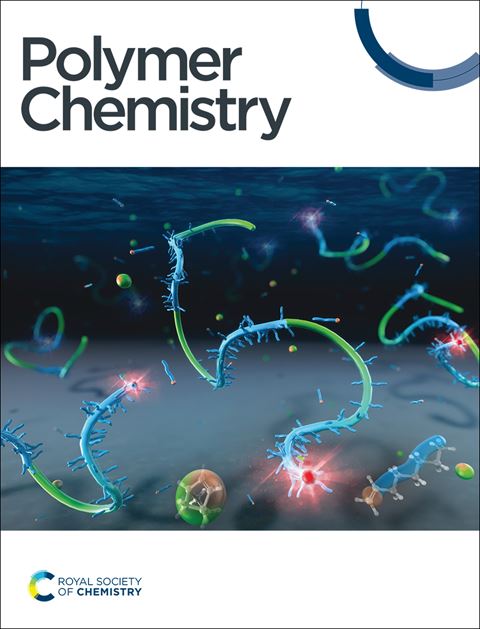基于动态C-N键的功能双光子微纳光敏材料的力诱导荧光响应
IF 3.9
2区 化学
Q2 POLYMER SCIENCE
引用次数: 0
摘要
环氧丙烯酸酯(EA)具有优异的热工性能、机械性能和化学稳定性,成为热固性树脂的典型代表。通过三唑啉二酮(TAD)与吲哚之间的化学键合,形成了不同质量比的EA聚合物。其中,80wt% EA-10:3的抗拉强度最高,为71.03 MPa,断裂伸长率为7%;90wt% EA-10:2.5的模量和硬度相对较好,分别为5.21 GPa和223 MPa。此外,90wt% EA-10:3聚合物具有良好的双光子聚合打印性能,扫描速度为100 μm/s ~ 100000 μm/s,激光功率为5 mW ~ 50 mW。同时,在激光功率为30 mW时,样品块体的模量和硬度分别达到5.12 GPa和230 MPa。采用原位弛豫荧光光谱法表征了力可逆聚合物网络中C-N键的动力学行为。这项工作提出了一种有价值的策略来增强EA聚合物在各种特殊性能材料应用中的功能,同时保持其强度和韧性。本文章由计算机程序翻译,如有差异,请以英文原文为准。

Force-induced fluorescence response of functional two-photon micro-nanofabrication photosensitive materials based on dynamic C–N bonds†
Epoxy acrylate (EA) has excellent thermal performance, mechanical properties, and chemical stability, making it a typical representative of thermosetting resins. Dynamic C–N bonds were introduced through chemical click reactions between triazolinedione (TAD) and indole, resulting in EA polymers with different mass ratios. Among them, the 80 wt% EA-10 : 3 had the strongest tensile strength of 71.03 MPa with an elongation at break of 7%, while the 90 wt% EA-10 : 2.5 had a relatively excellent modulus and hardness of 5.21 GPa and 223 MPa by nanoindentation testing, respectively. In addition, the 90 wt% EA-10 : 3 polymer exhibited good two-photon polymerization printing performance with scanning speeds of 100 μm s−1–100 000 μm s−1 and laser powers of 5 mW–50 mW. Simultaneously, the sample block exhibited mechanical properties with a modulus and hardness of 5.12 GPa and 230 MPa under the laser power of 30 mW. In situ relaxation fluorescence spectroscopy was used to characterize the dynamic behavior of the C–N bonds in force reversible polymer networks. This work proposes a valuable strategy to enhance the functionality of EA polymers in various special performance material applications, while maintaining their strength and toughness.
求助全文
通过发布文献求助,成功后即可免费获取论文全文。
去求助
来源期刊

Polymer Chemistry
POLYMER SCIENCE-
CiteScore
8.60
自引率
8.70%
发文量
535
审稿时长
1.7 months
期刊介绍:
Polymer Chemistry welcomes submissions in all areas of polymer science that have a strong focus on macromolecular chemistry. Manuscripts may cover a broad range of fields, yet no direct application focus is required.
 求助内容:
求助内容: 应助结果提醒方式:
应助结果提醒方式:


